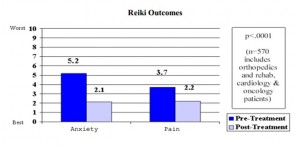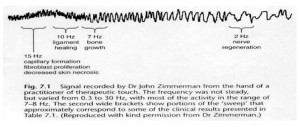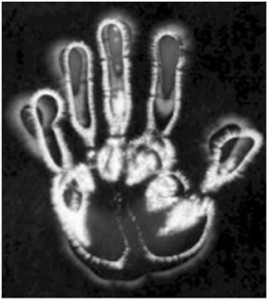Reiki Research and anxiety reduction
Following on from the previous post, Hartford Hospital, Connecticut carried out research, under Dr Molly Punzo, MD into using Reiki volunteers to reduce anxiety and pain across a number of departments in the main hospital, including Cardiology, Orthopaedic, Oncology, and Palliative Care units, as well as in the outpatient Cancer Centre. (Barnett, Libby, and Chambers, Maggie. Reiki Energy Medicine: Bringing Healing Touch into Home, Hospice, and Hospital (Vermont: Healing Arts Press, 1996).
During the pilot phase, outcome measurements were obtained from patients rating their anxiety and pain pre and post Reiki sessions. The Quality Management Department analysed the results which showed a statistically significant decrease in anxiety and pain regardless of the specialty area.
Reiki Energy Medicine: Enhancing the Healing Process
by Alice Moore, RN, BS, Reiki Master
Hartford Hospital Department of Integrative Medicine, Hartford, CT
With increasing frequency and confidence, we speak of Energy Medicine (also known as “energy work”) as if it was a new form of therapy for our patients’ ailments. Not so. Thousands of years ago ancient cultures understood intuitively what scientific research and practitioners world-wide are confirming today about the flow (or lack of flow) of energy in the body and, how the use of energy therapies can enhance the healing process.
As well known medical surveys report approximately 50% of the American public using some form of complementary or alternative therapy, “energy work” is among the ten most frequently used. Research has shown that these therapies (often called “mind-body-spirit techniques”) can help decrease anxiety, diminish pain, strengthen the immune system, and accelerate healing, whether by simply inducing the “relaxation response” (and reversing the “stress response” which subsequent impacts on the body, illness, and disease) or, by more complex mechanisms.
When patients choose these options, there is often a greater sense of participation in healing and restoration of health and, patient satisfaction is often increased in the process.
It was with this understanding that Women’s Health Services at Hartford Hospital began to integrate Reiki healing touch (one of the most well known forms of “energy work”) on the inpatient gynaecological surgical unit in 1997. Patients have been very pleased to be offered an option that is so relaxing and helps decrease their anxiety as well as their discomfort. Comments from patient satisfaction questionnaires include:
- “I am so grateful for the pain relief and peacefulness I felt after the Reiki session”
- “Reiki was the highlight of my day and I am so thankful to the volunteers”
- “I would highly recommend this program. I feel the Reiki helped me recover faster.”
- “I’ve had major surgery before but never with your wonderful Reiki healing touch sessions. I was overwhelmed with a sense of peace and gentle calm which helped me immensely during my hospital stay this time.”
- “I hope Reiki is always available because it helped me a lot in relaxing and healing, giving me energy to think positive and forget the bad things wrong with me. I thank you for Reiki, it really, really helped me!”
- “I felt the Reiki program helped me to deepen my breathing patterns which in turn reduced my pain.”
- “This was a wonderful part of my stay at Hartford Hospital. The Reiki sessions I received were the highlight of my day. It is super that this is being offered to patients. Keep it up!”
After the tremendous success of this program, the formal Integrative Medicine Program under the direction of Dr. Molly Punzo, M.D. was developed in 2000 incorporating Reiki Pilot Programs on the Cardiology, Orthopaedic, Oncology, and Palliative Care units, as well as in the outpatient Cancer Centre. During the pilot phase, outcome measurements were obtained from patients rating their anxiety and pain pre and post Reiki sessions. After analysis by the Quality Management Department, the results not only showed a decrease in anxiety and pain, but a statistically significant decrease regardless of specialty area (see following diagram):

Reiki Outcomes at Hartford Hospital
(Benson, Herbert, MD. The Relaxation Response (New York: Avon Books, 1997).
This was also in line with JACHO’s (Joint Commission on Accreditation of Healthcare Organizations) recent focus on offering non-medicinal options for relief of anxiety and pain.
More formal research is currently being proposed. Reiki has become an integral part of the traditional medical care on these previous “pilot” units utilizing approximately 60 Reiki Volunteers trained and validated by the hospital. As the word spreads, and as the program is being expanded to other areas of the hospital, the Department of Integrative Medicine also receives a growing number of special requests daily.
Based on this concept of energy flow and “intention,” using the SQUID (superconducting quantum interference device) magnetometer, Dr. John Zimmerman of the University of Colorado Medical School has been able to measure not only a difference in the vibrational frequency coming from the non-trained and trained practitioners’ hands, but from the trained practitioners a range from .3 Hz to 30 Hz. The most frequent measurement observed was 7-8 Hz (the vibrational frequency found most often in nature in harmony and in the music that research has shown to be the most healing). This research was also later confirmed in Japan.
This range of frequencies correlates with the varying vibrational frequencies of healthy tissues and organs. The range also incorporates the frequencies used in the electromagnetic treatment equipment now being used in traditional medicine to accelerate healing in bone, skin, etc. (see the following diagram from Energy Medicine, a Scientific Basis by Dr. James Oschman). (Oschman, James, PhD. Energy Medicine: The Scientific Basis (NY: Churchill Livingston, 2000).

Signal recorded from the hand of a Reiki practitioner at Hartford Hospital
Since energy flow in the body is not an easily understood or accepted concept, a personal experience or the ability to measure and document is certainly helpful, especially for the more sceptical mind. In addition to the magnetometer, Kirlian photography (a Russian discovery) can help us see the energy emanating from the body, show us how it changes with stress, thoughts, emotions, etc., and as the following diagram conveys, specifically shows the energy from the hand.

Kirlian photography shows Reiki energy emanating from a hand
Although we are beginning to measure energy fields and energy transference, the mechanism for Reiki and other “hands-on” techniques is still uncertain. Since the practitioner’s hands are placed over the energy pathways used by acupuncturists, is there a release of endorphins as in acupuncture? Is there a release of nitric oxide since cells in which nitric oxide is produced are influenced by energy fields? We’ll have to wait and see. Until recently, alternative and complementary therapies including “energy work” were felt to be too mysterious, confusing, and controversial to be approached scientifically. Now science and energy practitioners are discovering similar results. However, waiting for the research does not change the fact that patients are seeking healing options such as Reiki and giving us very positive feedback. (Gerber, Richard, MD. Vibrational Medicine: New Choices for Healing Ourselves (NM: Bear and Co. Publishers, 1996).
Being hospitalized is rarely a patient’s first choice. However, having access to skilled physicians and staff, as well as the opportunity to integrate additional healing options such as Reiki into their care, can sometimes be life enhancing for our patients and help them feel calmer, more comfortable, more empowered, and more in control during a very stressful time for them. Although modern medicine has tended to focus more on the physical aspects of healing, we are coming full circle learning that healing is more holistic when we incorporate these “mind, body, spirit techniques”.
Jeffrey Migdon, MD in the “Alternative Advisor” very concisely summed it up by saying “The face of healthcare is changing…moving toward a more open-minded view of nonconventional remedies…some new, some long forgotten.”
Thanks to Hartford Hospital. For more information.http://www.harthosp.org/integrativemed/therapies/reikitherapy/default.aspx
Comments are currently closed.